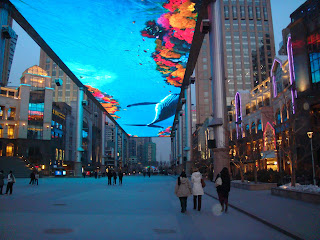
The Forbidden City is an enormous palace complex that lies in the very centre of Beijing and is surrounded by a moat. All the ring roads around Beijing are concentric to the Forbidden City. It was the imperial palace for the Ming and Qing Dynasties and was off limits to ordinary people for over 500 years. Twenty-four emperors ruled China from here until 1911 and the buildings and treasures inside represent some of the high points of ancient Chinese achievement. As a symbol of imperialism it was narrowly saved by Premier Zhou Enlai from being trashed by the Red Guards during the Cultural Revolution

. It's now called the Palace Museum and you walk into the complex under a large picture of Mao Zedong.
After we ran the gauntlet of tour guides offering their services, map sellers, flag sellers, book sellers, art touts, Chinese tour groups and people wanting to practice their English ("Helloooo, helloo where you from?") we walked through the Meridian Gate, over the Golden Stream (frozen) and through the Gate of Supreme Harmony. We found ourselves in another world.
The outer courtyard was where all the business of ruling China happened, in the three main buildings, the Hall of Supreme Harmony, the Hall of Middle Harmony and the Hall of Preserving Harmony.
One of the less harmonious moments in the outer courtyard's history saw thousands of crates of the palace treasures removed by Kuomintang forces during the Cultural Revolution. They also scraped off the gold from some of the urns used to store water for firefighting in the Forbidden City. The treasures eventually ended up in Taiwan

where they are now housed in a newly-built national museum there.
The Inner courtyard, partitioned into various parts, was the home to successive emperors and empresses and of course the many concubines and eunuchs who were part of the court.

The gardens lie beyond and are full of fantastically-shaped rocks and trees, pavilions and walks.

I want a lodge like this at my place!


Wood panel detail from the concubine's area in the West Inner Courtyard.


There are museums within museums here, including a clock museum and a jewellery museum.

The Nine Dragon screen.
I will go back to the Forbidden City. It seems to occupy not only the central part of Beijing but a central part of the Chinese psyche. People we saw today are tremendously proud of the Forbidden City. My words can't describe the immenseness of the complex; let's just say it's an all day job to visit.

 Robbie's 12th birthday with Mr Thomas Chan the magician at Trader's Hotel.
Robbie's 12th birthday with Mr Thomas Chan the magician at Trader's Hotel. A pedicab tour around Xuanwu Hutong
A pedicab tour around Xuanwu Hutong

 The Great Wall.
The Great Wall. Robbie approaching national monuments with his usual reverence.
Robbie approaching national monuments with his usual reverence.





























 Clare, Ian and I went to Longqing Gorge about an hour and a half north of Beijing and just north of Badaling, one of the popular sections of the Great Wall. Longqing Gorge is a dam, but in winter it is
Clare, Ian and I went to Longqing Gorge about an hour and a half north of Beijing and just north of Badaling, one of the popular sections of the Great Wall. Longqing Gorge is a dam, but in winter it is 























 or cabbage ginger and peanuts. Here is Mrs Liu, cooking the dumplings.
or cabbage ginger and peanuts. Here is Mrs Liu, cooking the dumplings.
